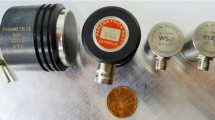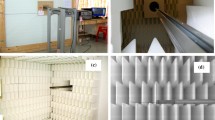Abstract
The National Metrology Institute of Japan has developed a free-field reciprocity calibration system for type WS3 microphones as acoustic standards in the airborne ultrasonic range between 20 and 100 kHz, because numerous instruments radiate airborne ultrasound. Precise calibration of these microphones requires minimizing the influence of sound reflected from the objects such as absorbing wedges and supporting rods within the acoustic chamber. To minimize this influence, we applied the virtual pulse method, which is a signal processing technique used in the audible frequency to airborne ultrasonic range. Experimental and analytical results validated this method. Use of this method in the calibration of type WS3 microphones will decrease the calibration uncertainty in the free-field sensitivity level.








Similar content being viewed by others
References
W.I. Acton, A Criterion for the Prediction of Auditory and Subjective Effects due to Airborne Noise from Ultrasonic Sources, Ann. Occup. Hyg, 11 (1968), 227-234.
WHO, Environmental Health Criteria Monographs No. 22 Ultrasound, WHO, 1982.
International Radiation Protection Association, Interim Guidelines on Limits of Human Exposure to Airborne Ultrasound, Health Physics, 46(4) (1984), 969–974.
Guidelines for the Safe Use of Ultrasound: Part 2. Industrial and Commercial Applications, Environmental Health Directorate, Canada, 1991.
American Conference of Governmental Industrial Hygienists, Documentation of the Threshold Limit Values for Physical Agents, 7th edn, ACGIH, 2001.
Specifications for Working Standard Microphones, International Standard IEC 61094-4:1995, IEC, 1995.
H. Takahashi et al., Free-field Calibration of 1/4 inch Microphones for Ultrasound by Reciprocity Technique, 4th Joint Meeting of Acoustical Society of America and the Acoustical Society of Japan, Hawaii (2006) pp. 3234.
Primary Method for Free-field Calibration of Laboratory Standard Microphones by the Reciprocity Technique, International Standard IEC 61094-3:1995, IEC, 1995.
T. Fujimori et al., Measurement of Acoustic Center Position of LS2P Laboratory Standard Microphones. J. Acoust. Soc. Jpn, 58(9) (2002), 579–585 (in Japanese).
F.J. Harris, On the Use of Windows for Harmonic Analysis with the Discrete Fourier Transform, Proceedings of the IEEE, 66(1) (1978), 51–83.
A. Papoulis, Signal Analysis, McGraw Hill (1977).
Author information
Authors and Affiliations
Corresponding author
Rights and permissions
About this article
Cite this article
Takahashi, H., Horiuchi, R. Minimizing the Effects of Reflections by Using a Virtual Pulse Method, for Free-Field Reciprocity Calibration. MAPAN 27, 191–198 (2012). https://doi.org/10.1007/s12647-012-0031-z
Received:
Accepted:
Published:
Issue Date:
DOI: https://doi.org/10.1007/s12647-012-0031-z




